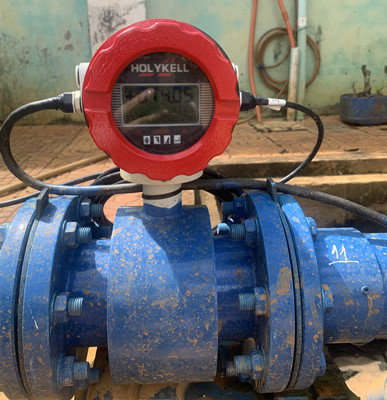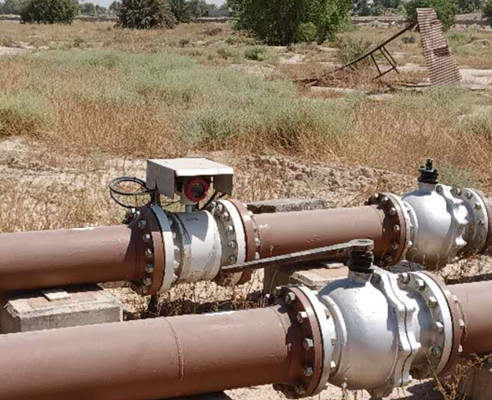Common Faults & Troubleshooting of Magnetic Flowmeters
When utilizing electromagnetic flowmeters, facing common questions necessitates examining three critical aspects:
I. Working Environment
Due to complex application scenarios, the magnetic flowmeter installation environment should avoid exposure to lightning, high temperatures, humidity, corrosion, field frequency interference, electromagnetic disturbances, and fluid noise. Implementing appropriate solutions based on encountered interference types is essential to ensure the stability and anti-interference capability of electromagnetic flow meters.
II. Installation Position
1. Ensure a straight pipe section before the flow meter with a length greater than 10 times the diameter and a straight pipe section after the flow meter with a length greater than 5 times the diameter. Click here for more guidance on installation requirements.
2. Ensure that the measuring pipe is filled with liquid, without empty or partially filled sections(full pipe electromagnetic flow meters).
3. Improper sensor placement, such as at the highest point of a gas-accumulating pipe network or on vertically descending pipes, may lead to air entrapment issues, affecting the proper functioning of the electromagnetic flow meter if there is no backpressure.

III. Measurement Medium
The measurement medium must be a conductive liquid; non-conductive liquids like oil or pure water cannot be measured.
Additionally, factors like the presence of bubbles, high solid content in some fluids, and uneven conductivity in mixed media can affect the magflowmeter’s normal operation. Read our previous post for details here.
IV. Inaccurate Flow Measurement
When experiencing measurement inaccuracies or fluctuations, we first need to determine what the measurement values are compared against. Typically, we use a water pump for comparison. It’s important to note that a water pump cannot measure electromagnetic flow meters, but electromagnetic flow meters can measure the flow of a water pump. The flow of a water pump is influenced by factors such as pipe length and height, resulting in deviations, and it can only serve as a reference value
Consider the following:
1.Ensure the pipe is full; incomplete filling can cause inaccuracies.
2.Check for pump blockages, especially when measuring sewage. For insertion-type electromagnetic flow meters, inspect if the probe is obstructed.
3.Examine if the medium is prone to scaling, as scaling can lead to inaccurate measurements.
4.Presence of bubbles in the liquid.
5.Low conductivity of the electromagnetic flow meter, leading to inaccurate measurements.
6.Electrode corrosion affecting measurement accuracy.
7.External strong electric fields causing measurement inaccuracies.
8.Deformation of the magflow meter liner leading to inaccurate measurements.
9.Verify if bypass pipes are closed by the user.

V. Unstable Flow
2. Inspect for high-frequency variable interference near the instrument.
VI. No Flow Display
1. Backlight not displaying: Check if the fuse is blown and if the indicator lights on the power board are lit.
2.Backlight flashing: Check the excitation circuit for shorts and ensure proper insulation.
3.Inspect alarm Messages (SYS, FGP)
SYS Excitation Alarm:
For integrated models, it may indicate a line break. For split models, check the resistance between EXT+ and EXT- with a multimeter (usually 55-60 ohms). If there’s no resistance, inspect cables for damage before checking the sensor.
FGP Empty Pipe Alarm:
Confirm if the pipe is full.
For split models, short-circuit the signal lines to observe if the alarm disappears, indicating a functional converter.
4.When there is flow, FGP (Empty Pipe) alarm:
The low conductivity of the measured medium leads to an empty pipe alarm. Adjust the empty pipe threshold to normalize it. The default empty pipe threshold is 500.
5.Initially, there is flow, but after a while, the flow becomes zero:
Check if the sensor liner is damaged. Due to the influence of time, medium and installation pressure, the liner may suffer damage. The measured medium may flow into the conduit and cable, causing a short circuit between the electrode and cable, resulting in no flow signal output.
6.No alarm messages (SYS, FGP), no flow display, but velocity (FLS) is detected:
Check if the flow direction matches the arrow indicated on the flow meter.
7.The LCD screen is not lit:
First, check if there is power. Then, inspect the rear fuse to see if it is damaged. If the fuse is not damaged, the issue may be with the circuit board.
8.No readings:
Probable reasons; non-full pipe, insufficient conductivity, or very low velocity.
9.The LCD screen displays negative flow:
The electromagnetic induction coil inside may be connected incorrectly. Reset it and modify the positive flow to negative flow.
VIII. 4-20mA No Current Output
2. Mainboard damage due to lightning, moisture, high temperatures, or incorrect wiring.
3. Verify the user’s power supply for compliance.
IX. No Pulse Output
2. For split models, check if the dip switch’s second terminal is switched on.
3. For integrated models, insufficient pulse power may require external 24V voltage.
FAQs
1.Can electromagnetic flow meters measure in partially filled pipes?
For electromagnetic flow meters requiring full pipes, accuracy cannot be guaranteed. In such conditions, it is advised to use non-full tube electromagnetic flow meters designed for applications of pipes.
2.Why Does A Magnetic Flow meter Need Grounding





